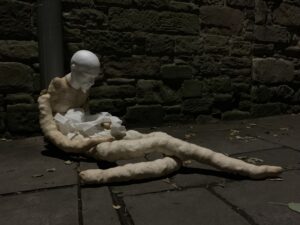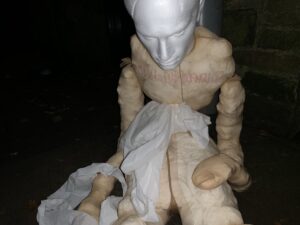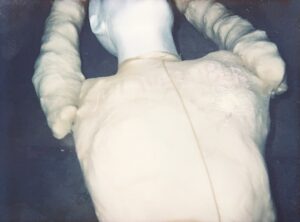I decided I wanted to emphasize the vulnerability of the inanimate object by creating the impression of it falling apart. I ripped a hole in the mannequin’s torso, and pulled some of the stuffing out. The pose of the mannequin is peculiarly human, but the clearly doll-like stuffing is helplessly being held by the imitation of a living person. It stares defencelessly at its damaged body. I wanted the pose to make the figure look exhausted and drained rather than stressed and tense. He looks as if life had spilled out of him, and he was looking helpless at his loss. I made the legs of the mannequin elongated. This urges the viewer to keep in mind that although this installation is supposed to represent a human being, it is not anatomically correct by any means. This makes the viewer realize that the emotions he’s feeling are directed at a lifeless object.
Before taking the final Polaroid photographs, I had to find the appropriate frame and positioning of the photo. I began by making a few pictures from different angles and lighting. I also experimented with several variations and poses with the mannequin. After that I chose four main shots that I wanted to reproduce using polaroid photography. I’m aware of the shortcomings of this method but I wanted to see what the Polaroid camera would do to pictures shot from the same perspectives. For my final setting I found a dark, narrow street with only one street lantern turned on. The whole scene gave me a feeling of ghostliness and squalidness. Darkness crept into every crevice of the road; the only light source was the lantern, which lit the setting lightly with a yellowish light. The Polaroid pictures came out very satisfactory. It is interesting to see the contrast between the digital photographs and the ones made using the instant camera. The Polaroid photos are flat and lack the chiaroscuro effects. The absence of detail and the simplicity of the pictures force the viewer into looking at this scene as a whole, rather than focusing on certain parts of the photograph.
In the two close-up photographs, I think it’s clear that I was inspired by Walker Evans. The main difference between my Polaroid photos and his lies in the fact that his photographs are strictly of humans, while mine are of an imitation of a person. This creates an intriguing comparison. The gaze of the subjects in Walker Evans’s Polaroid photos is what drew me to his work the most. Even though it is impossible to recapture a person’s stare when working with a mannequin, I think that the lighting and the characteristics of Polaroid photography call forth a saddened and crestfallen gaze.









